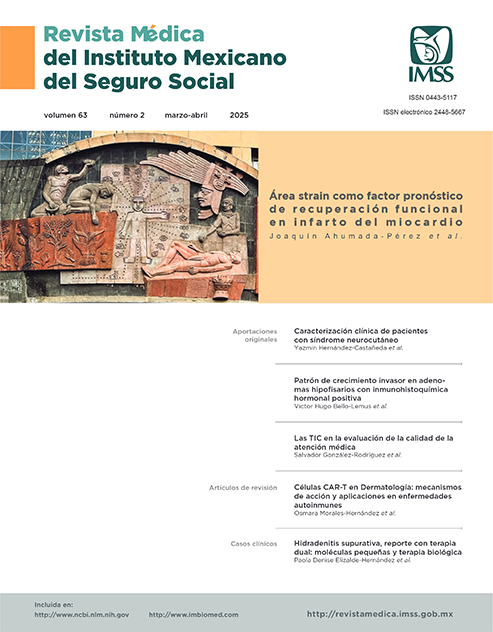Resultados quirúrgicos en pacientes con cáncer esofágico en un centro de tercer nivel
##plugins.themes.themeEleven.article.main##
Palabras clave
Enfermedades Gastrointestinales, Neoplasias Esofágicas, Esofagectomía, Adenocarcinoma Esofágico
Resumen
Introducción: el cáncer esofágico es la séptima neoplasia más diagnosticada, siendo los hombres quienes presentan una mayor prevalencia. El consumo de tabaco, alcohol, la enfermedad por reflujo gastroesofágico y el esófago de Barrett se asocian al desarrollo de adenocarcinoma y carcinoma de células escamosas.
Objetivo: identificar los resultados quirúrgicos en pacientes con cáncer esofágico en un centro de tercer nivel.
Material y métodos: estudio transversal y observacional. Se evaluaron pacientes con cáncer de esófago entre enero de 2014 y julio de 2019. Las variables de estudio fueron: sexo, edad, tipo histológico, complicaciones posquirúrgicas, mortalidad y sobrevida.
Resultados: se evaluaron 34 pacientes, con edad promedio de 61.8 ± 8.9 años. El 88.2% eran hombres. La localización del tumor fue: tercio inferior (76.5%), tercio medio (17.6%) y tercio superior (5.9%). El tipo histológico más frecuente fue adenocarcinoma (67.6%) y carcinoma de células escamosas (32.4%). La sintomatología fue: disfagia en 34 (100%) y epigastralgia en 20 (58.8%). Los tipos de cirugía realizados fueron: transhiatal en 15 (44.1%), paliativa en 15 (44.1%), Ivor Lewis en 1 (2.9%) y McKeown en 1 (2.9%). Las complicaciones postquirúrgicas incluyeron: respiratorias (29.4%), fuga de anastomosis (20.6%), sepsis (11.8%) y fístula (2.9%). La mortalidad fue de 13 (38.2%) pacientes y la sobrevida a los 22 meses fue del 22%.
Conclusiones: nuestro estudio evidenció una mayor prevalencia de cáncer esofágico en hombres mayores de 60 años con adenocarcinoma localizado en el tercio inferior del esófago. A pesar del tratamiento quimioterapéutico, la sobrevida de los pacientes continúa siendo de mal pronóstico debido a que el diagnóstico tardío, en estados avanzados de la enfermedad, limita la operabilidad y resecabilidad de los tumores, lo que incrementa la mortalidad.
Referencias
Sung H, Ferlay J, Siegel RL, et al. Global cancer statistics 2020: GLOBOCAN estimates of incidence and mortality worldwide for 36 cancers in 185 countries. CA Cancer J Clin. 2021;71:209-249. Disponible en: https://doi.org/10.3322/ caac.21660
Huang J, Koulaouzidis A, Marlicz W, et al. Global Burden, Risk Factors, and Trends of Esophageal Cancer: An Analysis of Cancer Registries from 48 Countries. Cancers (Basel). 2021;13(1):141. Disponible en: https://doi.org/10.3390/ cancers13010141
[INEGI (2015). Estadísticas de Mortalidad. Cubos dinámicos; y CONAPO (2015). Proyecciones de la Población 2010-2050
Morgan E, Soerjomataram I, Rumgay H, et al. The Global Landscape of Esophageal Squamous Cell Carcinoma and Esophageal Adenocarcinoma Incidence and Mortality in 2020 and Projections to 2040: New Estimates From GLOBOCAN 2020. Gastroenterology. 2022;163(3):649-658.e2. Disponible en: https://doi.org/10.1053/j.gastro.2022.05.054
Qin X, Jia G, Zhou X, et al. Diet and Esophageal Cancer Risk: An Umbrella Review of Systematic Reviews and Meta-Analyses of Observational Studies. Adv Nutr. 2022;13(6):2207-2216. Disponible en: https://doi.org/10.1093/advances/nmac087
Katada C, Yokoyama T, Yano T, et al. Drinking alcohol, smoking, multiple dysplastic lesions and the risk of field cancerization of squamous cell carcinoma in the esophagus and head and neck region. Annals of Oncology. 2019;30(6):296. Disponible en: https://doi.org/10.1093/annonc/mdz247.0917
Tarazi M, Chidambaram S, Markar S. Risk Factors of Esophageal Squamous Cell Carcinoma beyond Alcohol and Smoking. Cancers (Basel). 2021;13(5):1009. Disponible en: https:// doi.org/10.3390/cancers13051009
Uhlenhopp DJ, Then EO, Sunkara T, et al. Epidemiology of esophageal cancer: update in global trends, etiology and risk factors. Clin J Gastroenterol. 2020;13(6):1010-1021. Disponible en: doi:10.1007/s12328-020-01237-x
Yang J, Liu X, Cao S, et al. Understanding Esophageal Cancer: The Challenges and Opportunities for the Next Decade. Front Oncol. 2020;10:1727. Disponible en: https://doi.org/10.3389/ fonc.2020.01727
Li N, Sohal D. Current state of the art: immunotherapy in esophageal cancer and gastroesophageal junction cancer. Cancer Immunol Immunother. 2023;72(12):3939-3952. Disponible en: https://doi.org/10.1007/s00262-023-03566-5 11
Batra R, Malhotra GK, Singh S, et al. Managing Squamous Cell Esophageal Cancer. Surg Clin North Am. 2019;99(3):529- 541. Disponible en: https://doi.org/10.1016/j.suc.2019.02.006
DiSiena M, Perelman A, Birk J, et al. Esophageal Cancer: An Updated Review. South Med J. 2021;114(3):161-168. Disponible en: https://doi.org/10.1016/j.suc.2019.02.006
Li S, Xie K, Xiao X, et al. Correlation between sarcopenia and esophageal cancer: a narrative review. World J Surg Oncol. 2024;22(1):27. Disponible en: https://doi.org/10.1186/ s12957-024-03304-w
He S, Xu J, Liu X, et al. Advances and challenges in the treatment of esophageal cancer. Acta Pharmaceutica Sinica. 2021;11(11):3379-3392. Disponible en: https://doi.org/10.1016/j. apsb.2021.03.008
Ohkura Y, Miyata H, Konno H, et al. Development of a model predicting the risk of eight major postoperative complications after esophagectomy based on 10826 cases in the Japan National Clinical Database. J Surg Oncol. 2020;121(2):313-321. Disponible en: https://doi.org/10.1002/jso.25800
Watanabe M, Otake R, Kozuki R, et al. Recent progress in multidisciplinary treatment for patients with esophageal cancer [published correction appears in Surg Today. 2020;50(1):12-20. https://doi.org/10.1007/s00595-019-01878-7
Peng J, Kukar M, Mann G, et al. Minimally Invasive Esophageal Cancer Surgery. Surgical oncology clinics of North America. 2019;28(2):177-200. Disponible en: https://doi.org/10.1016/j. soc.2018.11.009
Xing H, Hu M, Wang Z, et al. Shortterm outcomes of Ivor Lewis vs. McKeown esophagectomy: A meta-analysis. Front. Surg. 2022;9:950108. Disponible en: https://doi.org/10.3389/fsurg.2022.950108
Zhang T, Hou X, Li Y, et al. Effectiveness and safety of minimally invasive Ivor Lewis and McKeown esophagectomy in Chinese patients with stage IA–IIIB esophageal squamous cell cancer: a multicentre, non-interventional and observational study. Interact Cardio Vasc Thorac Surg. 2020;30(6):812- 819. Disponible en: https://doi.org/10.1093/icvts/ivaa038
Takahashi C, Shridhar R, Huston J, et al. Comparative outcomes of transthoracic versus transhiatal esophagectomy. Surgery. 2021;170(1):263-270. Disponible en: https://doi.org/ 10.1186/s12893-022-01875-7
Soltani E, Mahmoodzadeh H, Jabbari Nooghabi A, et al. Transhiatal versus transthoracic esophagectomy for esophageal SCC: outcomes and complications. J Cardiothorac Surg. 2022;17(1):150. Disponible en: https://doi.org/10.1186/s13019-022-01912-9
Ohkura Y, Shindoh J, Ichikura K, et al. Perioperative risk factors of psychological distress in patients undergoing treatment for esophageal cancer. World J Surg Oncol. 2020;18(1):326. Disponible en: https://doi.org/10.1186/s12957-020-02092-3
D’Journo XB, Boulate D, Fourdrain A, et al. Risk Prediction Model of 90-Day Mortality After Esophagectomy for Cancer. JAMA Surg. 2021;156(9):836-845. Disponible en: https://doi. org/10.1001/jamasurg.2021.2376
Watanabe M, Toh Y, Ishihara R, et al. Comprehensive registry of esophageal cancer in Japan, 2015. Esophagus. 2023;20(1):1- 28. Disponible en: https://doi.org/10.1007/s10388-022-00950-5
López P, Alberdi N, Fuertes I, et al. An updated review of the TNM classification system for cancer of the oesophagus and its complications. Radiologia (Engl Ed). 2021;63(5):445-455. Disponible en: https://doi.org/10.1016/j.rxeng.2020.09.004


